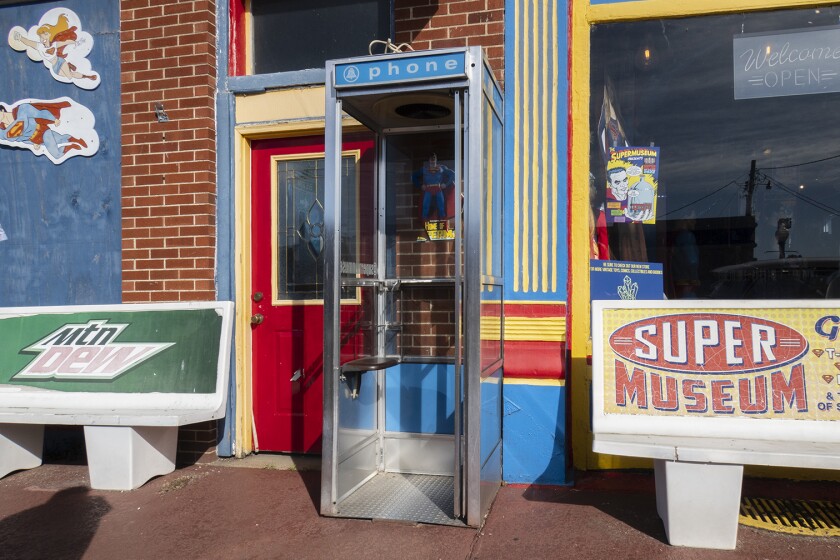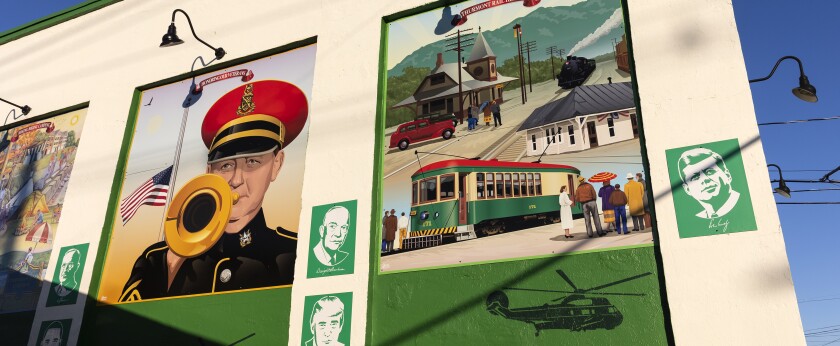
Photographs by David Kidd
By decree of the Illinois House of Representatives and DC Comics, owner of the copyright to Superman, Metropolis, Ill., was officially declared the “Home of Superman” in June of 1972. Plans for a nearby $50 million theme park to be known as “Amazing World of Superman” were soon announced. Visitors would enter beneath a 200-foot statue of DC’s superhero. The little city of 6,000 on the banks of the Ohio River was destined to become the epicenter of all things Superman.
But the Amazing World of Superman and its namesake statue were never built, victims of the oil embargo and a faltering economy. Instead of Superman’s likeness soaring hundreds of feet into the sky, the town made do in 1986 with a seven-foot-tall representation, rendered in fiberglass. It was much unloved.

The Super Museum on Superman Square has been in business since 1993, stuffed with more than 70,000 items amassed by its creator, Jim Hambrick. The collection started with the lunchbox he got on his fifth birthday and grew from there. Family owned and operated, the museum is looked after today by Hambrick, his daughter Morgan and son-in-law Adam Siebert. “I was a Marvel guy,” says Seibert, of his life before marriage. “I grew up with the X-Men. And here I am taking care of the museum, and the godfather of all superheros.”
The second-generation museum curator is the father of three daughters, Allison, Charlotte and Zelda. “No Lois,” he says. Having married into the job, he is not counting on his girls to take over some day. “I’m grooming them to do something that they want to do.”

Even though the museum and all the buildings around Superman Square seem to celebrate an earlier time in American life, Seibert insists that Superman is not a relic of the past. “Superman is just Superman,” he says. “He’s evolving with the culture. He’s been changing since he was created. Every single person who draws him, draws him different.” DC Comics recently decided that Superman will now fight for “Truth, Justice and a Better Tomorrow.” The old “American Way” was deemed too narrowly focused for a worldly superhero. Still, the chance to experience the Superman of an earlier era seems to be what brings people to town.

Tori Cook and Christie Gragg are visiting from Alabama. They came here specifically to see Superman and the museum. “I’ve been a lifelong Superman fan,” says Tori. “And this is just a really cool place.” Her highlight that morning was “getting to see all the memorabilia, like Marlon Brando’s wigs. Even stuff from the older movies and the TV shows.” The couple had planned to come for her 50th birthday in February, but the museum was closed for renovations.

Standing tall in his place of honor in downtown Metropolis, a few of today’s visitors notice that the Man of Steel is sporting a black armband. He wears it to honor two comic artists, George Perez and Neil Adams, who recently passed away within a month of each other. “Any of the artwork you see around town, that’s Neil Adams or George Perez,” says Siebert. “All the artwork for the signs in town, the billboards, the cutouts…”

As a boy, Super Museum owner Jim Hambrick charged his friends 5 cents to see his burgeoning collection of Superman memorabilia. He was happy to make a dollar a week. As he grew older, he sometimes worried what others would think of his passion for collecting. It is estimated that not more than 100 original copies of Action Comics No. 1 — featuring Superman’s first appearance — still exist. The cover price was 10 cents. In the past few years, at least two buyers have paid well over $3 million for a good quality example. Jim Hambrick owns three. Hambrick and the little town of Metropolis have arguably profited from their association with Superman, though maybe not as originally envisioned.

Related Articles












